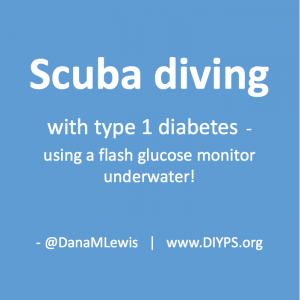 I just went scuba diving in Australia* at the Great Barrier Reef, and I took a flash glucose monitor (Libre) with me under the water.
I just went scuba diving in Australia* at the Great Barrier Reef, and I took a flash glucose monitor (Libre) with me under the water.
WHAT! Yes, really. Scuba diving with a Libre. (Your mileage may vary, of course! The Libre receiver is not waterproof in of itself, and obviously not rated/tested for depth. I did some of that testing for myself. See below 😉 )
—
Historically (and you can read more in this post for more detail on what else I do regarding pump, CGM, and everything else for scuba diving with diabetes and other diabetes devices), I only had a CGM that did not work underwater, and did not work for around an hour after I went diving since it would get waterlogged.
A few months ago when Libre was FDA approved in the US, I paid cash out of pocket (for a receiver + 3 sensors) to try it to see how it did compared to my CGM. For most purposes, a CGM still makes sense for me, because I rely on it for closed looping, and on its low and high glucose alarms. But I know from previous dives and other water activities that my CGM doesn’t work well after a long time in (deep) salt water: I often get false-positive highs for an hour (or more) afterward. So for this trip, I was thinking I would wear a Libre sensor for the dive trip, and just scan when I got out of the water, so I didn’t have to do a fingerstick test after every dive.
In the weeks leading up to our trip, I also saw a picture and heard rumblings of people going scuba diving and taking their Libre receiver under the water. I couldn’t find any details about it, though: What case? What depth? etc. ARGH.
So we decided to pick out a waterproof phone case and just give it a try during our trip. Worst case, we’d just ruin the receiver. Scott found this waterproof phone case/bag (<–Amazon affiliate link) and ordered it, and I packed it for the trip. Probably other similar phone cases would work, too – brand likely doesn’t matter, but you obviously would want a case that’s not going to leak, and should perform a leak test on it before you leave home.
—
We did a “liveaboard” for 3 days and 2 nights (really, ~48 hours on the boat). There’s a transfer boat that takes you out to the “liveaboard”, which is essentially a floating hotel. When you get there, you’re allowed to do a snorkel session before lunch; the first dive briefing is after lunch, and you can then dive during the sessions (max 3 day dives total and 1 night dive) after that during your stay. All this detail to explain that we popped the Libre receiver in the waterproof bag and took it into the water with us when we went snorkeling. And it worked great! So that gave me the courage I needed to take it down during our first dive.
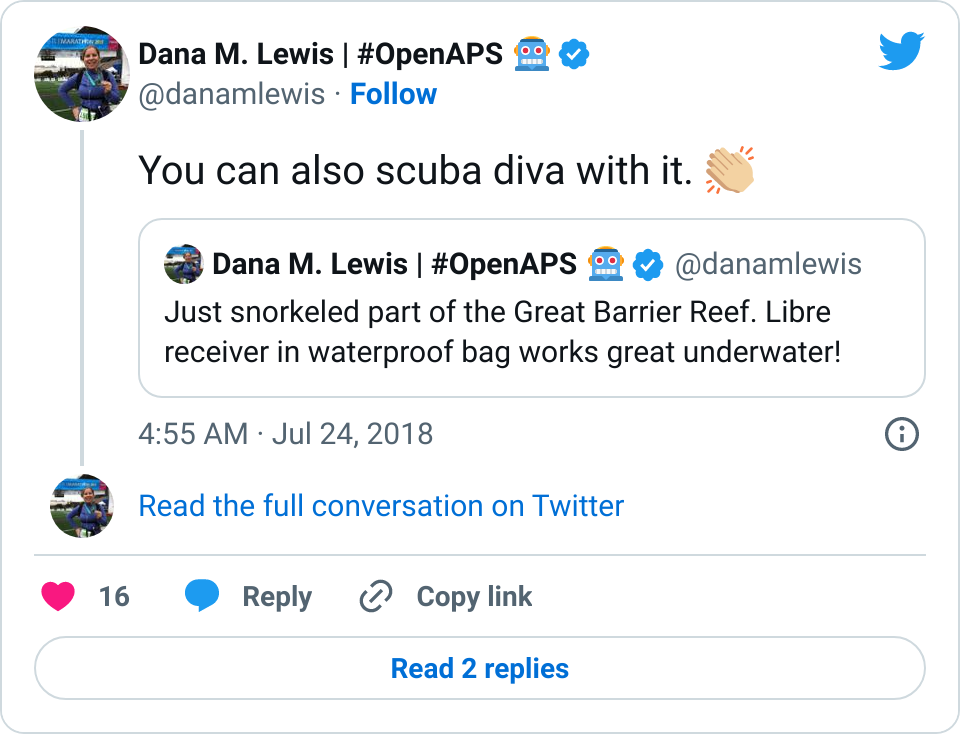
The waterproof case had a strap where you could wear it around your neck, which is what I did. That ended up being annoying occasionally (because the bag would float above you during the die, and sometimes got caught on my snorkel), but it worked. (For future trips I’d probably find a stretchy cord to attach it to my BCD where it was accessible but didn’t have to float or be hung around my neck.)
I wore two wetsuits (I get cold easily!), and even with two layers of wetsuit; the waterproof case; and you know, the water – I was still able to easily press the button on the Libre receiver through the bag, swipe it over my arm, and pick up a BG reading! It was super cool for it to work. The hardest part: finding the Libre sensor under 2 layers of wetsuit on my arm.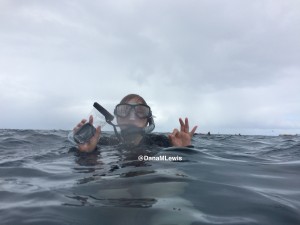
The first few dives were somewhat shallow – 9-12 meters of depth, but over the course of all my dives, I ended up testing it down to 16 meters. I also tested it on 9 total sessions – 1 snorkel, 2 morning sunrise dives, 2 night dives (whoa), and 4 daytime dives. The bag did fine throughout each submersion and never leaked.
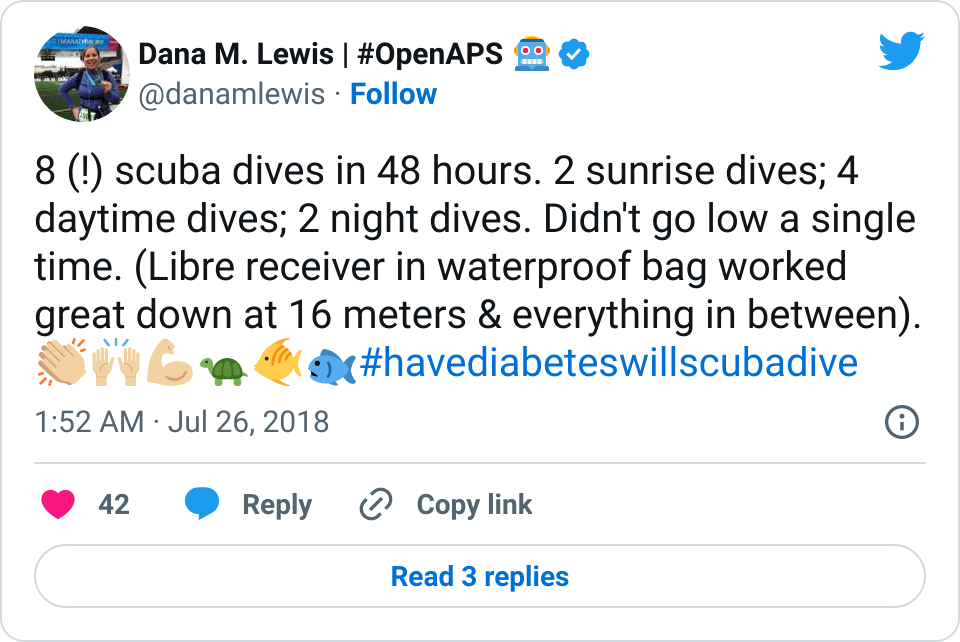
I was also expecting the sensor to peel up, so I did four strips of flexifix tape (like I do to my CGM sensor) around the outside edges of the sensor. The tape itself didn’t end up peeling up, and the sensor stayed on just fine! (It probably helped that I wasn’t sunscreening the edges of the tape, since I was pretty much in 2 layers of wetsuit every time I was out in the water and in the sun.) If the sensor ripped out, that would have been a pain as the one I have is the original one approved in the US that requires a 12 hour warmup (ugh) – thankfully, that didn’t happen, and also thankfully, the day we got off the boat we heard that the Libre is now approved in the US for 14 day wear (instead of 10) and now only ONE hour warmup (yay!). That’ll make it nice and easy (if I get the updated sensors) for future dive trips if a sensor rips off.
—
In terms of accuracy and sensor performance:
My first Libre sensor that I had tried at home a few months ago when we got it ran low pretty consistently, and ran REALLY low when my BG was normal. That drove me nuts and I was pretty sure that I wouldn’t want to rely on it the way some people do. So I was planning to not be able to rely on the numbers, and just use it for trends when diving. However, this second sensor (that I did all my scuba diving with) was spot on, even when high and low. I cross checked with finger sticks before and after the first dive, but quickly tailed off fingersticks (other than calibrating my CGM) for the most part, and was able to rely on Libre to double-check my CGM. (As expected, because of the waterlogging, the CGM ran falsely high, sometimes 100 mg/dL off, for about an hour after the dive.)
I left the Libre on even beyond the dive boat part of our trip, and it’s been spot on alongside my CGM (which is also spot on) compared to fingersticks.
—
So to summarize my experience: Libre is great for scuba diving. I tested it down to 16 meters and was happy with how it worked underwater! I loved being able to check mid-dive and see my trends. I never had a low during my 8 dives in 48 hours, and I never worried about going low since I wasn’t diving “blind” to my BGs. I definitely plan to use this for future scuba diving trips, and would also consider using it for any beach/water-based activities. The convenience is worth (for me) paying out of pocket cash for a few sensors to be able to access my BGs easily during these activities.

* One final note: Australia has some of the strictest diving laws in the world regarding your health. If you have type 1 diabetes, you have to have a very particular Australian dive medical form filled out before any company will let you dive. Now, many companies will tell you to just show up in Cairns and use the dive medical centers for a cheap and easy dive medical. HOWEVER: we called three of them in advance. One said “NOPE” out of hand to approving a (perfectly healthy) person with type 1, solely because that person (me) has type 1. The second wasn’t sure and asked us to email a full medical history to give us an opinion. They never responded to the email. The third didn’t answer phone or email. Ugh. So: my advice is, get the form, and go talk **in person** to your physician of choice about this and the necessary information needed to have a physician fill out this form. I stressed a lot about this; but once I handed in the special form along with the standard medical form everyone has to fill out – they didn’t say a word to me, ask me about diabetes, or prevent me from diving. So my advice is to go prepared with your form!

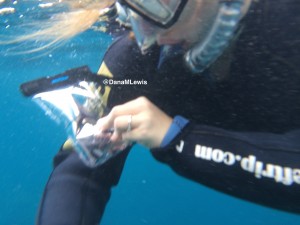
Interesting that you see accuracy issues after dives. I’ve been on 30 or 40 or more dives w dexcom and don’t see that . Mine reconnects after a few min on boat. We did an Agressor live aboard for a week and had no issues. I would consider bringing a second cgm for extra comfort / information while diving
Interesting! Which CGM are you using, Doug? And what length/depth of dives have you been doing? I’ve had Dexcom G4 and anything beyond 20 minutes of salt water submersion at depth causes the accuracy issues for me. It happens on newer and older sensors, so I don’t think multiple sensors would help (in my experience) – that’s why I got so much benefit from Libre on this trip.
This is fantastic! Thank you for sharing your experience diving with the Libre. I am definitely going to try this on my next dive.
Where was trip scuba diving?
Phone number?
Sounds like fun the liveaboard
We stayed on the https://reefencounter.com.au/, which cycles between a handful of dive sites on the Great Barrier Reef. You ride out to it on a day-trip boat from Cairns, and then transfer to the liveaboard for the duration of your stay.
I have a Dexcom G6 and want to do a beginner scuba class. The local instructor is concerned as he has never heard of CGM. And wants A document stating that the G6 months can go underwater And handle the underwater pressure.Any information you would have would be greatly appreciated.
Kalon orcutt
kdgorcutt@yahoo.com
Dexcom has a website describing the G6 transmitter’s water resistance: https://www.dexcom.com/faq/are-dexcom-transmitters-waterproof
I wouldn’t trust the sensor readings immediately after a dive for dosing insulin: you should also take your meter for doing a post-dive BG check.
Hello!
I have dived 7-8 times, max depth at 30m but I was not using Free style at that moment, just fingerstick test.
Now I’m planning to dive in 2 weeks in Malaysia and I would like to get the Advanced certification. However, I currently have the Free style and not sure if after 30m depth it will work.
How many meters depth did you reach with the Libre sensor and the waterproof bag?
Thanks a mil for your shared knowledge, it helps us a lot!
I think the deepest I did with the waterproof bag at the time was 16m? I just did another dive where I went down to ~45 feet (didn’t take the receiver, but was wearing the Libre sensor) & it read fine when I got back up, so I think pressure would’ve been fine at that depth, too. If you’re doing short dives (<45 min), it may not be worth taking it down, and just scan on the boat right before/after etc, but longer times it's probably worth trying it and seeing how it goes! Have fun!
I know you said your sensor read high afterwards, but did you have any idea how accurate it was in the water? Looking to do the same thing at greater depths, but I may find another solution if the Libre isn’t accurate under pressure.
Thanks!
Hey Joe – I was talking about the CGM sensor (in this case a Dexcom) reading falsely high after it gets waterlogged. The Libre read the same for me in the water and out of the water for me (with the caveat that for me it tends to run ~20 points lower regardless, so I know if it’s reading ~60mg/dL underwater I’m really ~80 mg/dL, etc., which is why I recommend people spend a few days with it prior to their first dive to get a feel for if it runs low/high for them), and didn’t seem to be impacted by the pressure. It’s still my go-to solution for diving, just used it again last week!
Has anyone attempted to use this configuration at more advanced depths (up to or past 40m for instance)?
I’m comfortably managing my sugars before/after dives only for standard depth/length recreational dives, but would be more comfortable if I could check if working technical dives as well (as opposed to just having glucose ready to drink if I start feeling hypoglycemic).
The Libre sensor would probably work fine. You would need to make sure to start with enough air inside the waterproof bag to ensure the pressure doesn’t crush the reader once all the air is compressed inside it. Probably worth a test.
Are you able to take in the sugar under water? If yes: how?
Hi there. Thanks for this blog piece, really insightful! I dive but haven’t applied the Freestyle Libre yet so was concerned about the sensor as I know it’s only water resistant. Did you have to do anything to the sensor the protect it from water? Any advice would be much appreciated.
If it’s at the halfway point or later in the life (or I’ll be doing multiple days of water activities), I tend to throw a piece of flexifix tape over it just to protect against me accidentally snagging it when getting my wetsuit on or off. But nothing needed for the sensor for water protection.
Hi Dana!
This information was really useful and is helping inform how I should treat my diabetes on an upcoming, 10-day live aboard. Can you advise how thick your wet suits were together? I will be wearing a 7mm and am concerned that I won’t be able to scan through that thickness. Thanks for any info!
I don’t recall the exact thicknesses: maybe Dana does. But the Libre should be able to scan through 7mm of wetsuit, winter clothing, or anything else.
Thanks!!
So useful,thanks! We usually fly blind with my son during dives and Dexcom (5 or 6) picks up when we get out of the water. I have a libre I bought as a back up and we may try it next time.
I am a Type 2 diabetic. I just went diving in Bahamas (stuart coves) and had the Libre sensor on my arm. I scrambled and found some duct tape to cover it and the skin around it on my arm both to keep it secure and also minimize the effect of salt water on it and the glue adhesive. Was also concerned about the pressure from the depth but nothing can be done to address that issue. Used some gauze to cover so the tape adhesive didn’t stick to the sensor. Wore a wet suit. Did two dives (1st at 20 meters). Had no issues with sensor readings or longevity. Was able to remove the tape after and sensor was just fine. Worked the balance of 7 days Remaining as normal. So sensor seems to keep working at depth.
Thank you to Dana and the others for this information and self-testing!
I am just starting to use Levels/Libre and I am a scuba instructor… so it’s great to know that you have all tested this – especially those that commented on the more advanced depths. I will also report back my experience after using this during frequent diving, during which I do often reach 40M during deep training and lionfish hunting dives! Thank you again
I have a 16 yr old son who is Type 1 and was certified in 2021. After seeing Dana’s intel on the Libre, we decided to try it. We had nine successful dives with two sensors. The first sensor was pulled off during some brotherly wrestling in the pool. It worked for 6 dives to depths of 60ft. On the 9th dive, we hit 75 ft. We had placed a large IV bandage over the sensor to help keep it in place. We believe this caused undo pressure at depth and caused the sensor to malfunction. It was great on all the other dives to be able to check his BS. We still do a fingerstick afterwards just to ensure the readings are correct. Thanks for all the feedback from this. Has anyone reached out to Abbott or DAN to discuss findings or to see if they are doing more research for Divers with Diabetes?
I also have a 16 year old son with type 1 diabetes. We just got back from Bonaire a couple days ago. We really wanted to try the Libre Flash Glucose Monitoring System while scuba diving after reading this post!
We did 13 dives during the 7 day trip, ranging from 40-95 ft depth. It worked!!!!!!
I purchased the TORRAS Icecube Waterproof Phone Pouch (new 2022 version) from Amazon for the Libre 2 Reader. The pouch seemed flimsy at first glance but it never leaked. To make sure the sensor didn’t fall off we used Skin-Tac and a Dexcom overlay patch (to hold the edges of the sensor on the skin) We did not cover the sensor itself with anything only the edges of the sticker part.
He was also wearing a Dexcom G6 sensor while diving (That is what he uses normally, only on land of course) The G6 sensor held up fine at deep depths underwater and gave accurate readings after diving when we got back to land.
Awesome! So glad ya’ll had a great time and so many successful dives! Thanks for sharing your tips, too.
Hi Dana
I am type 1 and returning back to diving, I have uses Libre 2 for a few years now and love it; thanks for all the info. What were your starting levels for a 30/40 min dive please, as this is the nervous bit, and what were your finish levels like ?
Yay for getting back to diving! Two things to consider: not only starting BG but also levels of insulin on board.
Personally, I like to start my short and long dives with relatively little insulin on board, and preferably BGs around 130-150 mg/dL. That’s personal preference, of course, and lots of experience exercising with different levels of IOB before different types of exercise. If I had more than about 0.5 units of IOB, I would probably carb before the dive, even if BG was >130 mg/dL, because I know that the insulin would be working while I was diving. Post-dive, the BG levels often depend on whether I had starting IOB and/or carbs on board; how long the dive was; and whether I was stressed while diving as that sometimes causes me to rise and a relaxed easy but longer dive causes me to drop a bit due to the exercise. If I was disconnected from my pump for a long time due to where I needed to leave it relative to getting into the water, and combined the going in/diving/getting out and back to my pump was longer than an hour and a half or so, then sometimes I’d run a little high by the time I get back to the car due to missed insulin in that time period. But, it’s easy to fix that once you’re done: my goal is to not go low (which makes me feel bad) and not to go high to the point of feeling icky from the missed insulin for too long.
I am a type 1 diabetic and have been most my life. I have been diving for 22 years minus the last 3 years due to covid stuff. I have always used finger sticks in the past and made sure I was above 150 before entering the water and carried glucose tubes with me. I plan to head to Cozumel in January and now have the Libre 3 that is connected to my phone. It is so good to know that the sensors will hold up to salt water and depths. I will probably not worry about checking in water but will see how it compares after a dive to the finger sticks. Thanks everyone for sharing.
Let us know how it goes with the Libre 3 – and hope you have a great trip!
For deep dives and waterproof bags, remember your basic gas laws–at 5 ATM (132 ft), your bag will have an air space only 1/5th than at the surface–so blow that sucker up as big as you can when you seal it to prevent damage–should work well!
For shallow dives (<40 feet) and what most people will dive at, not much of an issue. You don't want to have too much air either or you won't be able to press buttons or screens inside your bag.